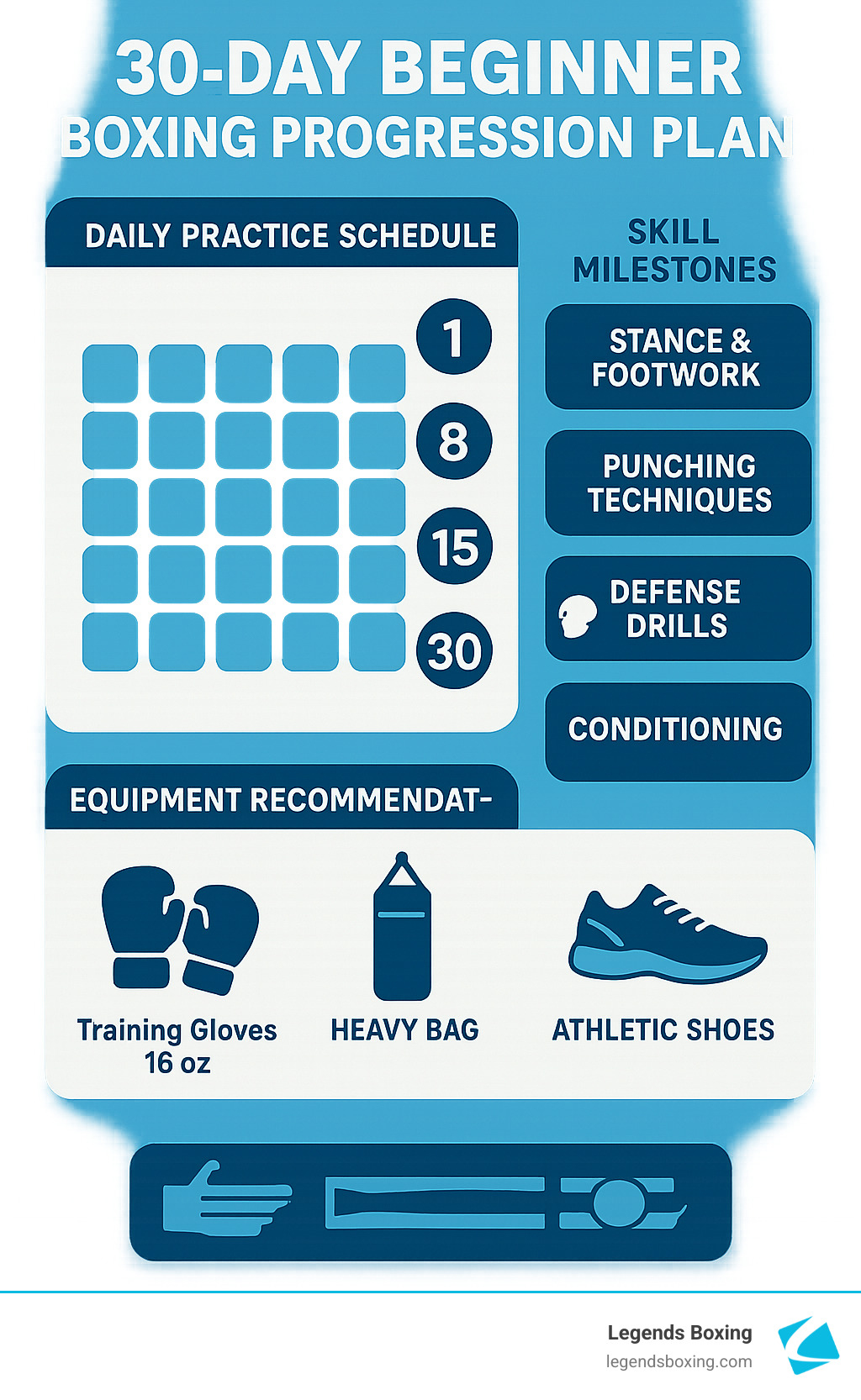From Rookie to Rocky – Basic Boxing Moves for Beginners
Why Boxing is the Perfect Workout for Busy Professionals
Basic boxing moves for beginners offer one of the most effective ways to break free from boring gym routines while building real strength, confidence, and stress relief. Whether you're stuck in workout plateaus or simply need an engaging way to stay active, boxing delivers a full-body experience that burns 500-800 calories per hour and boosts your mood through endorphin release.
The six fundamental boxing moves every beginner should master:
- Jab (1) - Quick, straight punch with lead hand
- Cross (2) - Power punch with rear hand
- Lead Hook (3) - Circular punch with front hand
- Rear Hook (4) - Circular punch with back hand
- Lead Uppercut (5) - Upward punch with front hand
- Rear Uppercut (6) - Upward punch with back hand
Boxing may look intimidating, but it's actually built on simple, learnable movements. The numbered punch system makes it easy to follow combinations, while proper stance and breathing techniques ensure you're training safely from day one.
The beauty of boxing lies in its accessibility - you can practice these moves at home with minimal equipment or join a supportive gym community. Studies show that boxing training can improve cardiovascular health by 13% and increase coordination by 20% in just your first three months.
I'm Robby Welch, National Head Coach at Legends Boxing with over two years of experience helping beginners master basic boxing moves for beginners through our nationwide coaching programs. I've personally guided hundreds of rookies through their first punches and watched them transform into confident, skilled athletes who love their workouts again.
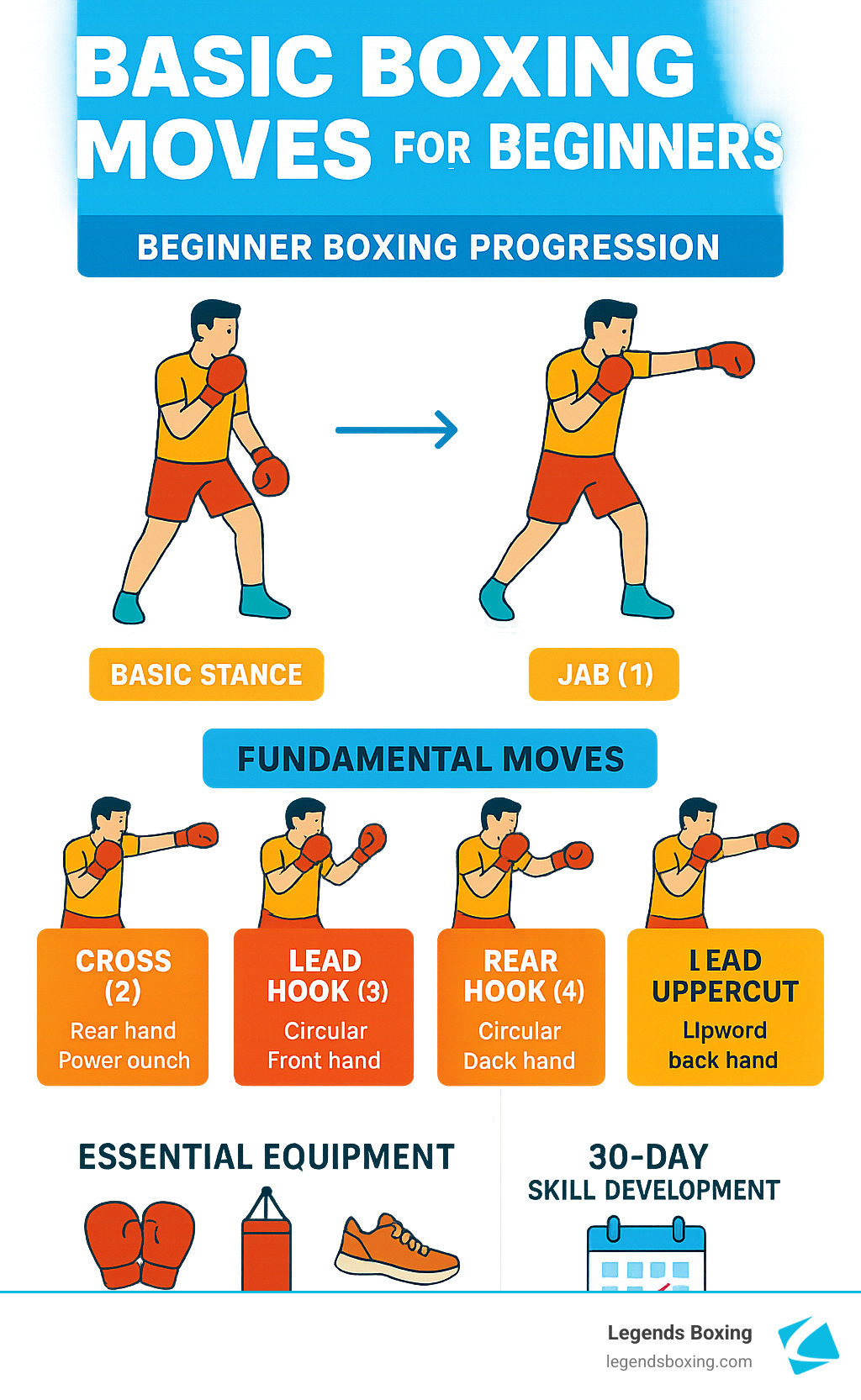
Basic boxing moves for beginners terminology:- basic boxing defense moves
Why Boxing Rocks: Benefits, Gear & Safety
Boxing transforms your body and mind in ways that'll surprise you. When you're throwing basic boxing moves for beginners, you're not just learning to punch – you're torching calories at an incredible rate of 500 to 800 per hour. That's more than most gym workouts can promise!
Your heart gets stronger too. Studies show that just 8 weeks of consistent boxing training boosts your VO2 max by 13%. That means better endurance, whether you're climbing stairs or chasing after your kids.
But here's what really gets me excited about boxing: the mental game-changer. Boxing crushes your stress hormones while flooding your system with the good stuff – endorphins, serotonin, and dopamine. It's like nature's antidepressant, but way more fun than a pill bottle.
I've watched countless members walk into our Legends Boxing locations looking defeated by their day. Thirty minutes later? They're practically glowing with renewed confidence and genuine smiles.
Essential Gear for Beginners
Starting your boxing journey shouldn't drain your bank account. You can begin practicing basic boxing moves for beginners with surprisingly little gear.
Hand wraps are your absolute first purchase – think of them as insurance for your wrists and knuckles. Next, grab 16 oz boxing gloves for beginners. The extra weight provides proper cushioning and helps you build strength gradually.
A mouthguard protects your pearly whites during any partner work, and regular athletic shoes work perfectly fine when you're starting out. Want to level up your training? A jump rope will transform your footwork and cardiovascular conditioning.
Here's the best part: many boxing gyms, including our Legends Boxing locations, provide equipment for new members. You can even practice shadowboxing with zero equipment – just you, a mirror, and the determination to learn.
Budget tip: Start with basic hand wraps and gloves for under $50. You'll be throwing proper punches in no time without the sticker shock.
Safety First: Injury Prevention
Your body needs proper preparation before diving into boxing moves. Start every session with 5-10 minutes of light cardio – jumping jacks or jogging in place work perfectly. Follow up with arm circles and shoulder rolls to wake up your joints.
Cooling down is just as important as warming up. Stretch those shoulders, arms, and core muscles after every session. Your body will thank you tomorrow.
Remember this golden rule: boxing is 90% mental. Listen to your body religiously. Start slowly and build intensity gradually over weeks, not days. Muscle soreness is normal and expected, but sharp pain means stop immediately.
The beauty of learning basic boxing defense moves is that proper technique actually prevents injuries. When you learn correctly from the start, you're building safe habits that'll serve you for years to come.
Scientific research consistently shows that exercise like boxing delivers powerful mental health benefits alongside the physical change you'll see and feel.
Build Your Foundation: Stance, Footwork & Breathing
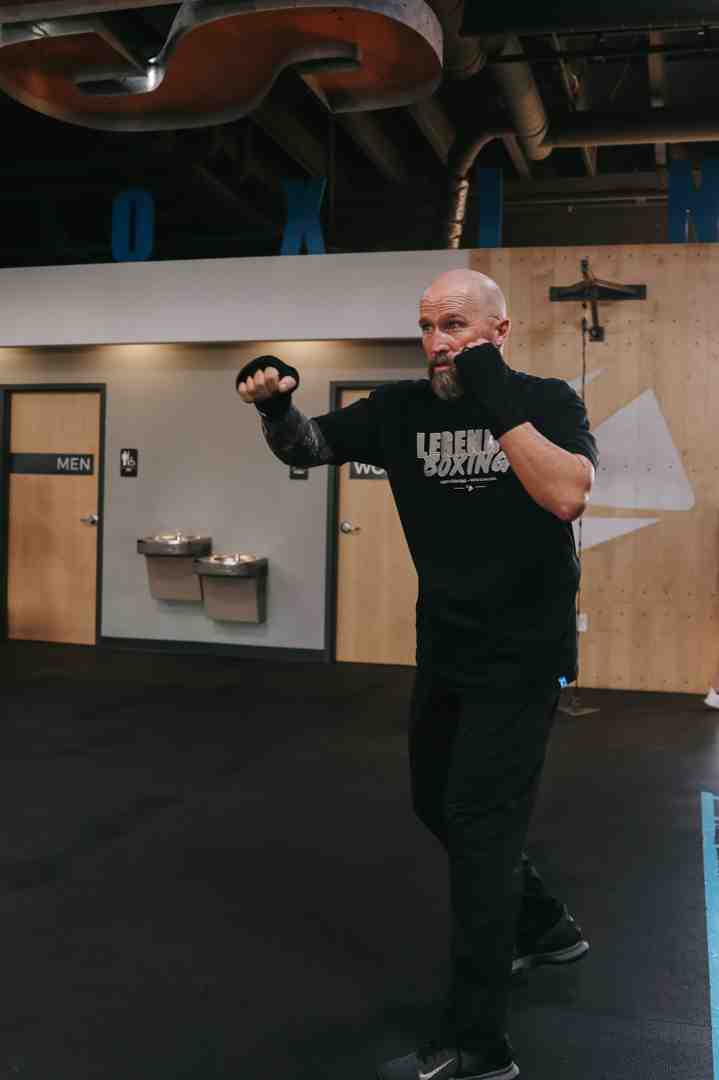
Think of your boxing stance as the foundation of everything you'll do in the ring. Without a solid base, even the most powerful basic boxing moves for beginners will fall apart. It's like trying to build a skyscraper on quicksand – you need that rock-solid foundation first.
The Boxing Stance
Most beginners feel awkward in their first boxing stance, and that's completely normal. Your body isn't used to this position yet, but with practice, it becomes as natural as walking.
For orthodox stance (if you're right-handed), place your left foot forward and right foot back, keeping them shoulder-width apart at about a 45-degree angle. Your weight should rest evenly on the balls of your feet with your knees slightly bent – this keeps you mobile and ready to move in any direction.
Here's where many beginners go wrong: they keep their back heel flat on the ground. Instead, keep that back heel slightly raised. This simple adjustment transforms you from a sitting duck into a mobile fighter who can move and punch with real power.
Your upper body positioning is equally important. Turn your left shoulder toward your target to make yourself a smaller target while keeping your chin tucked down and eyes up. Your hands should stay at cheek level with elbows close to your ribs – not flared out like chicken wings.
| Orthodox Stance | Southpaw Stance |
|---|---|
| Left foot forward | Right foot forward |
| Right hand power | Left hand power |
| 85% of boxers | 15% of boxers |
| Jab with left | Jab with right |
If you're left-handed, you'll use southpaw stance, which simply mirrors everything. Don't worry if it feels strange at first – even professional boxers spent weeks perfecting their stance.
Essential Footwork Patterns
Good footwork separates real boxers from people just throwing punches. The step-drag is your bread and butter movement. To move forward, step with your lead foot first, then drag your rear foot to maintain your stance width. Never, ever cross your feet – that's like putting a "hit me" sign on your back.
The pivot might be the most underrated move in boxing. Rotate on your lead foot to change angles, creating new attack opportunities or escaping trouble. Practice pivoting left and right until you can do it without thinking.
Your shuffle keeps you light and mobile. Think of it as controlled bouncing on the balls of your feet – small, quick steps that maintain your stance while keeping you ready to move. Great boxers look like they're dancing because they've mastered this rhythm.
Breathing ties everything together, and most beginners completely ignore it. Here's the pattern that will change your boxing: inhale through your nose during setup, then exhale sharply through your mouth on each punch. Make a sharp "hiss" sound – it engages your core and adds power to every punch.
This breathing rhythm does three crucial things: it times your punches perfectly, engages your core muscles for maximum power, and keeps your jaw closed for protection. Practice this even during shadowboxing until it becomes automatic.
To start practicing the proper boxer's stance
These fundamentals aren't just beginner stuff – professional boxers drill stance, footwork, and breathing every single day. Master these basics, and you'll have the foundation to build real boxing skills.
Basic Boxing Moves for Beginners: The Six Punches & Numbering System
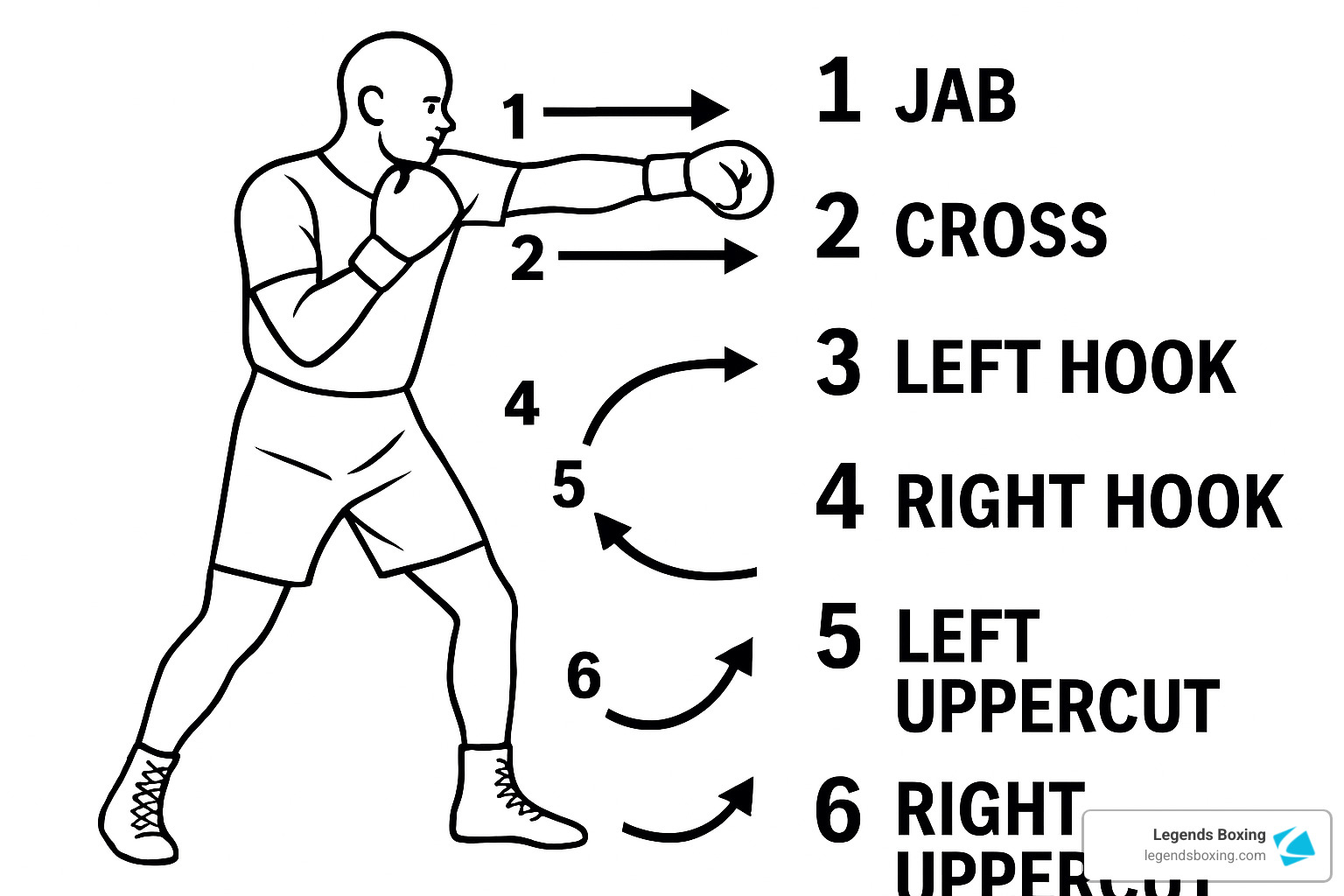
Here's something beautiful about boxing: walk into any gym in Tokyo, New York, or your hometown, and everyone speaks the same language. The 1-2-3-4-5-6 numbering system is boxing's universal code, making it incredibly easy to learn basic boxing moves for beginners.
Think of it this way – instead of your coach shouting "throw a jab, then a cross, then a lead hook," they simply call out "1-2-3!" Your brain processes those numbers instantly, and your body follows. In orthodox stance, odd numbers belong to your left hand and even numbers to your right hand. It's that simple.
This system transforms boxing from intimidating to approachable. When you hear combinations called out in class, you'll know exactly what to throw. Plus, it builds incredible muscle memory – your body starts moving before your brain even thinks about it.
The Six Basic Punches
The Jab (1) is boxing's workhorse punch. It's your range-finder, your setup tool, and your get-out-of-trouble card all rolled into one. From your boxing stance, snap your lead arm straight out while keeping that rear hand glued to your chin for protection. The magic happens in the snap – think of flicking water off your fingers, not pushing a heavy door.
Your fist should rotate so your palm faces down at impact, and then snap right back to guard position. Don't admire your work – get that hand back home fast! A good jab feels effortless but lands with authority.
The Cross (2) brings the power. This rear-hand punch generates force through hip rotation and weight transfer from your back foot. As you throw it, pivot on that rear foot like you're squashing a bug underneath – that's where your power comes from.
Drive your rear hand straight across your body while your shoulder comes up to protect your chin. Your hip rotation should feel like a spring unwinding. Done correctly, your shoulder actually touches your chin at the end of the punch. It's not just an arm punch – it's your whole body working together.
The Lead Hook (3) is where boxing gets artistic. This circular punch travels in a horizontal arc with your elbow locked at 90 degrees. The key is controlled rotation – pivot on your lead foot and let your hips do the work.
Don't swing wild like you're chopping wood. Instead, think of your arm as attached to your core, rotating as one unit. Keep that rear hand up for protection because hooks leave you momentarily exposed. When thrown correctly, the lead hook is one of boxing's most devastating punches.
The Rear Hook (4) combines your power hand with circular motion. Pivot on your rear foot and rotate your body like that same spring we talked about, but this time in the opposite direction. Your elbow stays at 90 degrees, and your fist travels in that same horizontal arc.
The rear hook requires excellent timing and hip rotation. Rush it, and you'll throw yourself off balance. Time it right, and you'll generate incredible power from that rotational force.
The Lead Uppercut (5) is your close-quarters weapon. Drop your lead shoulder slightly and bend your knees, then drive upward like you're trying to lift something heavy. Keep your elbow tight to your body – no chicken wings allowed!
The power comes from your legs driving up, not just your arm. Think of it as a controlled upward explosion that targets the chin or solar plexus. It's particularly effective when your opponent drops their guard or leans forward.
The Rear Uppercut (6) brings your power hand into the upward game. Drop into a slight squat, then rotate your hips as you drive upward with your rear hand. This punch combines the rear hand's natural power with upward momentum.
Like all uppercuts, keep it tight and controlled. The hip rotation is crucial – it's what separates a powerful uppercut from just lifting your arm up.
Memorizing Basic Boxing Moves for Beginners with the 1–6 System
The numbering system isn't just convenient – it's a learning accelerator that makes basic boxing moves for beginners stick faster. When your coach calls out "1-2-3," your brain doesn't have to translate complex movement descriptions. It just thinks numbers and reacts.
This system builds automatic responses through repetitive number patterns. Start with single punches – throw ten perfect jabs, then ten crosses. Focus on quality over quantity every time. Sloppy form at high speed teaches bad habits that are hard to break.
Progress to simple combo drills like 1-2, then 1-1-2, then 1-2-3. Each combination should feel smooth and natural before you add speed or complexity. Even professional boxers still practice these basic combinations daily – they're the foundation everything else builds on.
The beauty of this system shows up in class when your coach shouts combinations and you respond instantly, moving with speed and accuracy instead of confusion. That's when boxing starts feeling less like learning and more like flowing.
From Moves to Mastery: Combos, Defense, Drills & Progression
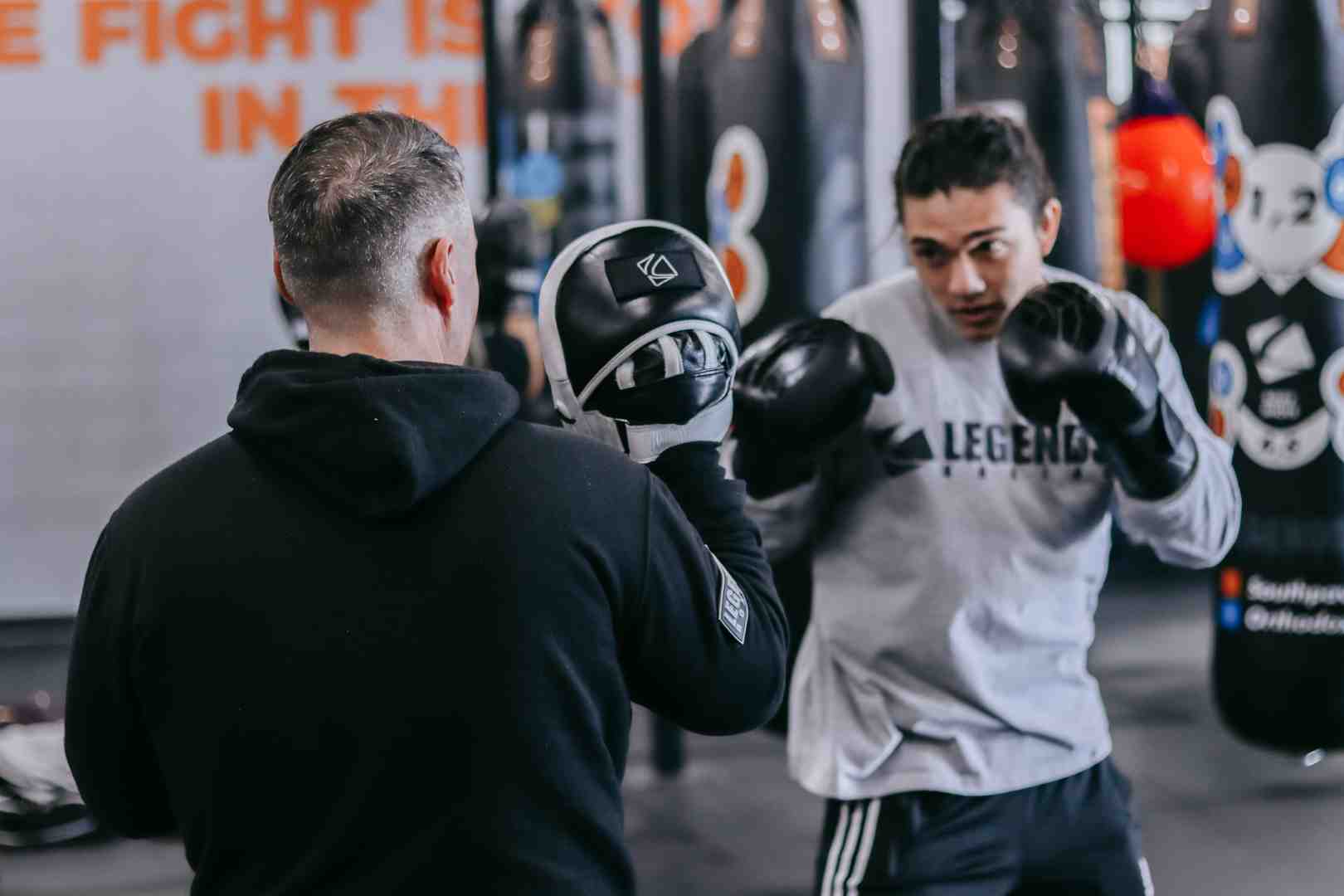
Here's where the magic happens. You've learned the six punches – now it's time to string them together into combinations that feel natural and powerful.
Essential Beginner Combinations
The 1-2 combination (jab-cross) is boxing's bread and butter. Champions like Floyd Mayweather built entire careers perfecting this simple combo. The jab creates the opening, and the cross delivers the power.
Once you're comfortable with the 1-2, add the 1-1-2 combination (double jab-cross). That extra jab keeps your opponent guessing and prevents you from getting lazy with your lead hand.
The 1-2-3 combination (jab-cross-lead hook) introduces your first three-punch sequence. This combo is beautiful because it changes angles – you go from straight punches to a circular attack.
For close-range work, try the 5-2-3 combination (lead uppercut-cross-hook). This sequence is devastating when you're in tight. The uppercut lifts their guard, the cross shoots through the opening, and the hook comes from the side.
Here's a pro tip: vary your punch speed within combinations. Start slow to disrupt their timing, then explode with your finishing punch.
Basic Defense: Your Shield
Defense isn't about being passive – it's about creating opportunities to counter-attack.
Blocking is your most basic defense. Use your gloves and forearms like a shield, keeping your elbows close to protect against body shots.
Slipping is where boxing becomes an art. You rotate your waist to move your head away from straight punches. This takes practice, but once you master it, you'll feel like you're dancing around punches.
Ducking requires you to bend at your knees and hips to go under hooks and overhand punches. Remember to keep your hands up while ducking.
Parrying uses slight deflection instead of rigid blocking. You redirect incoming punches rather than absorbing their full force.
Essential Training Drills
Shadowboxing is your best friend for practicing basic boxing moves for beginners. Just 10 minutes daily can increase your punch accuracy and coordination by 20%. The key is visualizing a real opponent – keep it real, keep it technical.
Jump rope training improves your footwork and gets your heart pumping. Start with 30-second intervals and work up to full 3-minute rounds.
Heavy bag work is where you can finally let loose, but remember: form first, power second. Practice your combinations slowly at first, then gradually increase speed while maintaining perfect technique.
Double-end bag training improves your hand-eye coordination and reflexes. This moving target teaches you to adjust your timing and accuracy in real-time.
Home Workout Essentials
You don't need a fancy gym to master these skills. Start with a 5-minute warm-up of arm circles and light shadowboxing. Your 20-minute main workout should include three rounds of shadowboxing, three rounds of combination practice focusing on 1-2 and 1-2-3 sequences, and two rounds of footwork drills. Finish with a 5-minute cool-down of stretching.
Progression Plan
Weeks 1-2 are all about mastering your stance and single punches. Weeks 3-4 introduce basic combinations like 1-2 and 1-1-2. Weeks 5-8 add defensive movements and more complex combinations. By months 2-3, you'll be incorporating advanced footwork drills and serious bag work.
Studies show that practicing basic boxing footwork drills can improve your balance and agility by up to 30% in just three months.
Common Mistakes to Avoid
Dropping your hands is the most common beginner mistake. Your gloves should snap back to your cheeks after every punch. Flaring your elbows doesn't add power – it just telegraphs your punches. Keep those elbows tight to your ribs.
Overcommitting to your punches throws off your balance and leaves you vulnerable. Don't lean into your punches – maintain your stance and be ready for whatever comes next. And please, don't forget to breathe.
Finding Your Boxing Community
Boxing is always better with others. Whether you join a gym like our Legends Boxing locations or connect with online communities, having support makes all the difference. Look for beginner-friendly environments with qualified instructors who emphasize technique over power.
At Legends Boxing, we've built our entire program around welcoming beginners. Our coaches understand that everyone starts somewhere, and we're committed to helping you progress safely and confidently.
Frequently Asked Questions about Beginner Boxing
Starting your boxing journey brings up lots of questions – and that's completely normal! I've been coaching beginners for years at Legends Boxing, and these are the three questions I hear most often.
How often should a beginner practice basic moves?
Here's the honest truth: consistency beats intensity every single time. I'd rather see you practice for 20 minutes three times a week than burn yourself out with one marathon 2-hour session.
Start with 2-3 sessions per week, giving yourself rest days between workouts. Each session should last 30-45 minutes initially – long enough to practice properly but short enough to maintain good form throughout.
Focus on quality over quantity. I tell all my beginners that 50 perfect punches beat 500 sloppy ones. Your muscle memory is like wet cement right now – whatever you practice repeatedly becomes permanent.
As your conditioning improves and the movements become more natural, you can increase to 4-5 sessions per week. But don't rush this progression.
Do I need a partner or coach to start?
You can absolutely begin learning basic boxing moves for beginners on your own. Shadowboxing, footwork drills, and basic combinations can all be practiced solo in your living room.
However – I strongly recommend getting professional instruction as soon as possible. Bad habits are incredibly hard to break once they're ingrained. It's much easier to learn correctly from the start than to unlearn poor technique later.
A qualified coach does four crucial things for beginners: they catch and correct mistakes before they become permanent habits, ensure you're training safely, provide personalized feedback that online tutorials can't match, and keep you motivated when the learning curve gets steep.
At Legends Boxing, beginners who start with proper instruction progress faster and stay injury-free compared to those who try to self-teach for months before joining us.
What glove weight is right for training vs sparring?
This question matters more than most beginners realize – the wrong glove weight can lead to hand injuries or poor technique development.
For training and bag work, stick with 16 oz gloves regardless of your experience level. The extra weight builds shoulder endurance while the additional padding protects your hands during long training sessions. If you weigh less than 120 pounds, 14 oz gloves are acceptable.
Sparring always requires 16 oz gloves, no exceptions. The extra cushioning protects both you and your partner during light contact work.
You might see experienced boxers using 12-14 oz gloves for speed bag work, but resist the temptation to copy them. Stick with 16 oz until you've developed proper hand conditioning and technique.
Competition gloves (8-10 oz) are only for actual fights – never use these for training.
At Legends Boxing, we provide all the equipment you need to get started safely. Our coaches will help you find the right gear as you progress in your boxing journey.
Conclusion

You've just learned the complete foundation of basic boxing moves for beginners – and honestly, that's something to be proud of. These six punches and fundamental techniques have launched countless boxing careers and transformed millions of fitness routines worldwide.
Think about where you started reading this guide. Maybe you were intimidated by boxing or stuck in a boring workout routine. Now you understand how the jab sets up your cross, how proper stance creates power, and why breathing with each punch protects your body while maximizing your strength.
The beauty of boxing lies in its simplicity. You don't need to master complex choreography or remember dozens of exercises. Just six numbered punches, proper stance, and consistent practice can deliver that incredible calorie burn, stress relief, and confidence boost we talked about earlier.
Every boxing legend started exactly where you are right now. Muhammad Ali threw his first awkward jab as a beginner. Floyd Mayweather had to learn the difference between a hook and an uppercut. The only difference between them and recreational boxers is daily practice and never giving up.
Your next steps are straightforward: start with shadowboxing for just 10 minutes daily, focus on perfect form over speed, and find a supportive community that encourages your progress. Whether that's practicing at home with a mirror or joining a welcoming gym environment, consistency beats perfection every time.
Safety should always be your top priority. Warm up properly, cool down completely, and listen to your body. Boxing is a marathon, not a sprint – building skills gradually prevents injuries and keeps you training for years to come.
At Legends Boxing, we've watched thousands of complete beginners find their inner fighter through these exact techniques. Our inclusive, results-driven classes turn "Rookie" into "Rocky" by focusing on proper fundamentals, supportive coaching, and celebrating every small victory along the way.
The hardest part of any fitness journey is taking that first step. You've already done that by learning these basic boxing moves for beginners. Now it's time to put them into action and experience the incredible physical and mental benefits that only boxing can deliver.
